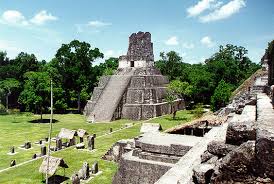The Maya created a brilliant civilization. They built massive stone pyramids and carved beautiful sculptures. They made great advancements in astronomy and math. The Maya recorded their history and discoveries using hieroglyphics, a form of picture writing.
A LONG HISTORY
Records of the Maya go back nearly 4,000 years. But the Maya civilization reached its peak from about 300 AD to 900 AD. During this time, the Maya controlled lands in southern Mexico, Guatemala, Belize, Honduras, and El Salvador.
Today, descendants of Maya people still live in parts of Mexico and Central America. Many still wear traditional clothes and speak their ancient languages.
INDEPENDENT CITIES
The ancient Maya lived in independent cities. Each city was ruled by its own king. Cities governed the villages and farmland around them. The biggest cities were Palenque, Tikal, Copán, and Chichén Itzá.
At the center of every Maya city was a large square, or plaza. Huge stone buildings bordered the plaza. These included tall pyramids with temples on top, palaces, and courts for playing a sacred ball game. Priests walked up steps of the pyramids to perform religious ceremonies in the temples. The Maya covered the walls of their buildings with brightly colored paintings.
Maya cities were home to many skilled workers. They included architects, weavers, potters, feather workers, and stone carvers. Merchants brought valuable goods to the cities from distant lands. Maya merchants traded jaguar pelts, jade, green parrot feathers, dyes, cloth, wax, honey, tools, and many other goods.
EXPERT FARMERS
Outside the cities, farmers lived in small villages near their fields. They were expert farmers and grew many different crops. The most important crop of all was maize (corn). Women ground the maize into a meal and baked it into flat cakes.
Other important crops included beans, squash, avocados, chili peppers, sweet potatoes, melons, and papayas. The Maya also grew cacao beans to make a chocolate drink. The Maya prized cacao beans. They traded the beans as a form of money.
RELIGIOUS BELIEFS
The Maya worshipped many different gods. Among the most important gods were Itzamna, the sky god, and Yum Kaax, the maize god. The Maya held many religious ceremonies in their city centers.
In some ceremonies, the Maya made sacrifices to the gods. They might sacrifice the life of a dog, turkey, or other small animal. Sometimes, for a very important ceremony, the Maya sacrificed a person. The victim was often painted blue and then sacrificed by a priest on top of a pyramid.
A GAME OF LIFE AND DEATH
The Maya played a sacred ball game on long courts in their city centers. The game involved two teams of players and a solid rubber ball. Players tried to hit the ball through a stone ring with their hips. They were not allowed to touch the ball with their hands or feet. The game was fast and dangerous. Players wore special padded clothing to protect them.
The ball game was not just a sport. It was also a sacred religious event. On certain occasions, the players who lost the game would be sacrificed to the gods.
ASTRONOMY AND MATH
The Maya developed astronomy and math to a high level. Maya astronomers carefully observed the positions of the planets and stars. Based on Earth’s orbit around the Sun, they learned that a year was 365 days long.
The Maya invented a system of math based on the number 20. Using this system, Maya astronomers designed a calendar that divided the year into 18 months of 20 days each. To these 360 days, the Maya added 5 “unlucky” days at the end of the year.
The Maya calendar was complicated and could only be read by people with special training. But for many centuries, the Maya calendar was the most accurate calendar in the world!
KEEPING RECORDS
The Maya developed an advanced form of writing using picture signs called hieroglyphics. They kept records of their myths, history, discoveries, and religious beliefs. They carved these records on buildings and on stone monuments called stelae.
The Maya also made books from long folded sheets of bark paper. Folded books like these are called codices. Only four Maya codices still exist. They cover subjects such as astronomy, the calendar, and religious ceremonies.
THE END OF THE MAYA
In about 900 AD, the Maya abandoned the cities of Palenque, Tikal, and Copán. No one knows why the Maya left these great cities, all located in the Guatemalan lowlands. Some scientists believe a long drought (lack of water) drove the Maya out.
Some Maya people moved north into the Yucatán peninsula in Mexico. There, they built the cities of Chichén Itzá and Mayapán. In the early 1500s, the Spanish invaded Mexico and conquered the remaining Maya.






0 comments:
Posting Komentar
komentar anda mengandung ribuan arti buat saya maka dari itu kritik dan sarannya ditunggu lewat komentar disini yaaaa.....
Rekor komentar : 15 komentar....tambahin yaaa hehe